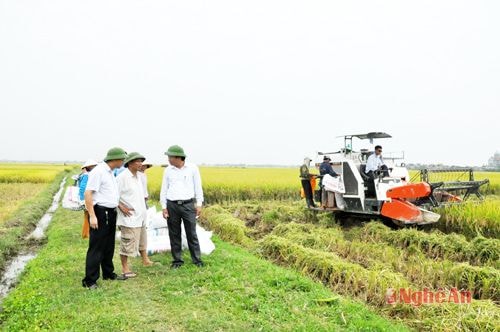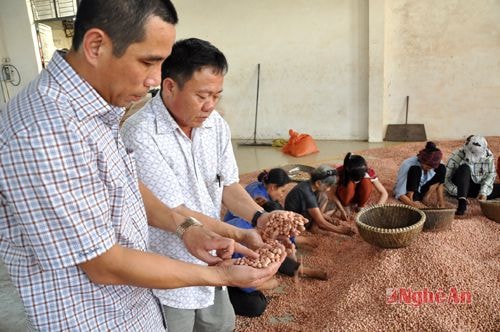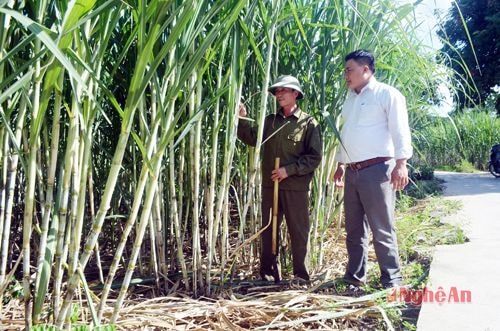Marks of the 2010 - 2015 term: Steady growth from agricultural production
(Baonghean) - In recent years, Nghe An agriculture has developed in both quantity and quality. With many appropriate solutions and policies, agriculture not only ensures food security but also creates high added value from key plant and animal varieties that are produced on a commercial scale. From there, it creates a solid momentum for the province's agriculture to develop in the following years.
Exceeded targetfood security
First of all, in rice production, there have been profound changes in localities considered as the province's rice granaries such as Yen Thanh and Quynh Luu. At the same time, localities with less favorable farming conditions have also made great strides in productivity, output and quality of rice. We visited Thanh Lien commune at the time when people were concentrating on harvesting the 2015 summer-autumn rice crop - a difficult production season due to drought and disease at the beginning of the season, with forecasts of a huge impact on productivity. Thanks to closely following the direction of the district and commune, people have structured varieties that are resistant to drought, pests and diseases, have a short growing period and give high productivity. Mr. Khuong Xuan Truc, hamlet 8, shared: "This summer-autumn crop, my family grows 6 sao of rice, thanks to good implementation of the commune's production direction on variety structure and crop calendar, the yield is still equivalent to last summer-autumn crop, reaching more than 5 tons/ha".
 |
| Quynh Luu district leaders discussed with farmers about the effectiveness of using combine harvesters. Photo: Huu Nghia |
With the same land and people, agricultural production in Thanh Lien today has undergone qualitative changes. Land conversion, from an average of 5.9 areas/household, has reduced to 1.89 areas/household, creating conditions for applying scientific and technological advances and mechanization into production, contributing to improving productivity and efficiency of agricultural production. Comrade Phan Ba Ngoc, Deputy Secretary of the Party Committee and Chairman of the Commune People's Committee, said: "After land conversion, the commune directed the conversion of areas that were not proactive in water to growing corn, squash or doing farm economics, which means that the rice production area is narrower than the previous term, but the output of the whole term still increased; especially the quality of rice is better".
Comrade Dang Anh Dung, Standing Deputy Secretary of Thanh Chuong District Party Committee, shared: “The majority of people in the district depend entirely on agriculture, so “if there is a good harvest, the people will not be rich, but if there is a bad harvest, there will be great danger”. Based on that characteristic, the guiding ideology of Thanh Chuong’s agricultural production in the 2010-2015 term is to be proactive and self-sufficient in food, both serving people and serving livestock development”. To achieve this goal, the district directed to focus on intensive rice cultivation in areas with proactive irrigation, not growing rice “at all costs”. Accordingly, high-lying areas without proactive water sources were converted to grow corn, vegetables of all kinds or to make farms. The district also proactively consolidated fields, exchanged plots, accumulated land, applied scientific and technological advances and mechanization into production; built model fields and large model fields in rice production; Along with that, synchronous planning and completion of the intra-field traffic network and irrigation canal system are carried out to meet the long-term needs for sustainable production. Thanks to that, Thanh Chuong agriculture has continuously had good harvests, achieving the goal of stabilizing food output of 100,000 - 105,000 tons of food per year, contributing to ensuring social security.
In the mountainous district of Que Phong, taking advantage of the relatively large rice area compared to the level of the highland districts, along with the application of new rice varieties suitable for soil conditions, applying the technique of fertilizing with bamboo in terraced fields, the district's rice production has made great strides in the last term. The total annual cultivated area reached over 7,880 hectares, of which the rice cultivation area increased from 4,117 hectares in 2010 to 4,391 hectares in 2015 (an increase of 274 hectares, an average increase of 55 hectares/year); the rice yield was quite good, estimated to reach 51.1 quintals/ha in 2015, an increase of 6.15 quintals/ha compared to 2010. Along with investing in productivity, the district has focused on investing in high-quality Japonica rice varieties, gradually forming specialized areas and building the brand "Muong Noc Fragrant Rice", gradually increasing post-harvest value. From there, the total food output in 2015 reached 24,771 tons, an increase of 2.9%; the average food output reached 369 kg/person/year.
Although the impact of climate change is increasingly evident and has many other impacts, with the initiative of the agricultural sector and the efforts of localities, Nghe An's food production in the 2010-2015 term still ensures growth in productivity, output and especially the added value in rice grains. Specifically, the output of grain food reached 1.2 million tons/year, exceeding the target set by the 17th Provincial Party Congress, 2010-2015 term. Besides the increase in output, it is worth mentioning that the proportion of high-quality rice varieties and commercial rice is structured at about 35-40% of the total cultivated area, contributing to increasing the added value in agricultural production when the price of high-quality rice increases by 10-20% compared to normal rice. To achieve these outstanding achievements, there is consistency in policies and implementation throughout the levels and sectors. The Provincial Party Committee has issued an Action Program to implement the Resolution of the 7th Central Committee (10th tenure) on agriculture, rural areas and farmers in Document No. 21-Ctr/TU dated October 31, 2010 and Resolution No. 03/NQ-TU dated June 6, 2011 of the Nghe An Provincial Party Committee on promoting the implementation of the National Target Program on New Rural Construction for the period 2011-2020. Directive No. 16/CT-TU dated July 24, 2013 on continuing to promote the implementation of Resolution No. 03-NQ/TU of the Provincial Party Committee, 17th tenure, on the new rural construction program for the period 2011-2020.
The mark that created success in the agricultural sector is that the Provincial Party Standing Committee promptly issued Directive 08, dated May 8, 2012, on land consolidation, plot exchange, and land accumulation, creating momentum for agricultural production in the direction of commodities. When small, fragmented plots are consolidated into large plots, creating conditions for farmers to invest in intensive farming; building model fields, large fields with the participation of enterprises, creating a value chain in rice production. Also through land consolidation and plot exchange, the internal traffic system and irrigation are strengthened one step, contributing to the mechanization of production, ensuring irrigation for rice plants. For the agricultural sector, it is to innovate leadership and direction of production in a practical and specific direction. At the beginning of each production season, the sector organizes many conferences and seminars to solicit opinions from scientists, experts, and enterprises; At the same time, continue to invite districts, cities, towns and related units to contribute ideas to mobilize the intelligence of scientists, businesses and state management in the production project. At the end of each production season, conduct frank and objective assessments and draw lessons. During the production direction process, demonstrate determination, seriousness, initiative and stick to the locality, stick to the base, promptly handle arising problems and difficulties.
Developing strong crops
Resolution of the Provincial Party Congress, term XVII, 2010 - 2015, clearly stated: "Planning and developing high-tech agricultural zones and regions, comprehensively developing agriculture in a modern, effective and sustainable direction". To implement that development viewpoint, during the term, the Provincial Party Standing Committee gave opinions to the Provincial People's Committee to promulgate the Projects on restructuring the agricultural sector towards increasing added value and sustainable development, period 2013 - 2020; Project on developing plants and animals mainly associated with land management mechanisms, creating raw material processing areas to serve domestic consumption and export in Nghe An province until 2020; Project on developing tea in Nghe An province, period 2011 - 2020; Rubber development project in Nghe An province, period 2011 - 2015... With the clear identification of advantageous crops, in the 2010 - 2015 term, the province has focused on planning, arranging the reasonable use of production land, applying science and technology to invest in intensive cultivation, increasing productivity and value of traditional crops including cassava, tea, sugarcane... and has also deployed a number of new crops such as rubber, passion fruit, raw material forests, medicinal herbs; associated with modern processing industry, aiming to increase value per unit area, increase competitiveness in domestic and foreign markets; From there, strive to achieve added value in agriculture from 4 - 4.5%/year in the period 2013 - 2020.
 |
| Select peanuts before packaging. Photo: Huu Nghia |
For some crops such as tea, although the area target set by the 17th Provincial Party Congress, 8,000/12,000 ha, has not been met, there has been progress in intensive investment, application of science and technology to increase productivity, while increasing capacity and in-depth processing capacity, increasingly meeting market demand, especially the export market. Specifically, tea productivity in 2014 reached 120 quintals/ha, up 4.4% compared to the plan; the province's tea output reached 75,000 tons of fresh buds, meeting the planned target. Currently, the province has 87 processing facilities with a total designed capacity of 878 tons/day, far exceeding the ability to meet raw material needs. According to comrade Ho Viet An, Party Secretary, Chairman of the Board of Directors, General Director of Nghe An Tea Investment and Development One Member Co., Ltd., in order to increase the added value of tea plants, in the 2010-2015 term, the company's Party Committee has innovated and improved corporate governance in the direction of paying attention to all stages from raw material production to product processing and marketing, creating "vertical" linkages, forming a value chain in tea production and trading in Nghe An; reorganizing products according to the market, meeting the technical "barriers" of other countries, creating a sustainable market.
Traditional sugarcane is grown in Nghia Dan, Quy Hop, Tan Ky, Anh Son districts and some other districts. The cultivation of sugarcane is closely linked to the consumption factory, bringing stable income to farmers in many highland localities. To improve the productivity and quality of sugarcane, some regions, businesses and farmers have joined together to invest in drip irrigation systems for productivity up to 100-120 tons/ha. By applying scientific and technological advances on sugarcane fields, the problem of raw materials for processing factories in the area has been solved. Up to now, the total area of sugarcane in the province is about 30,000 hectares, of which the harvested area is about 28,600 hectares, meeting the congress target. Sugarcane output is about 2 million tons, meeting the capacity of 3 sugar processing factories in the province.
As for cassava, based on the approved planning with a total area of 10,000 hectares, the Department of Agriculture and Rural Development has focused on directing localities planned for cassava cultivation to actively expand the area and introduce new cassava varieties. Up to now, the whole province has 4,000 hectares of cassava, with a yield of about 400 quintals/ha; the output is about 160,000 tons, providing enough raw materials for 2 cassava starch processing factories in Thanh Chuong and Yen Thanh. To ensure the development of the raw material area associated with processing, in parallel with the expansion of the area, the province has also oriented to continue building 3 cassava starch processing factories, first of all, the factory in Hoa Son, Anh Son district has started construction. In addition, the area of citrus trees with high value such as oranges and tangerines is growing strongly in districts such as Quy Hop and Con Cuong, bringing in hundreds of millions of VND per hectare.
 |
| Mr. Nguyen Van Tao (left), Chau Que hamlet, Chau Dinh commune, Quy Hop district, discussed the effectiveness of sugarcane production on family life. Photo: Thanh Duy |
Along with traditional crops, in the 2010-2015 term, the province has also actively directed the development of new crops based on the potential and strengths of the locality to exploit land, increase land use value, and increase income for people. The most prominent is wood raw material trees with 14,000 hectares, providing for businesses processing wood chips, pulp...; contributing to exploiting land funds, creating income for people, contributing to increasing the forest cover of the whole province to 55%. In the future, when the MDF artificial board production project in Nghia Dan has a capacity of 300,000m3 of bar board and MDF wood products/year; a number of bar wood and fuel coal processing projects in some localities come into operation in the 2015-2020 term, it will create new conditions for raw material trees to develop and increase higher added value. Passion fruit, a highly effective plant variety that has been successfully replicated in the mountainous district of Que Phong, is opening a path to sustainable poverty reduction for ethnic minorities in this mountainous area. Currently, a 1,500-hectare raw material area has been planned and its area is increasingly expanding with the effective participation of both businesses and scientists. Particularly, rubber trees and medicinal plants have gradually formed a raw material area and will be put into exploitation in the next term, opening a new direction for Nghe An's agricultural economy in a sustainable direction. In particular, in the past term, Nghe An has emerged as a center for the application of high-tech agriculture in the country through a system of dairy farms associated with raw material areas and a dairy product processing factory of TH Group deployed in Nghia Dan district.
Over the past 5 years, the picture of Nghe An's agricultural sector has been outlined with many bright colors, gradually forming a clear foundation for the next stage of development. In the trend of international economic integration, especially in the coming time, when our country joins the Trans-Pacific Partnership Agreement (TPP), the agricultural sector will face many opportunities and challenges. Opportunities are equally divided among farmers nationwide, including the agricultural sector and farmers of Nghe An. In order not to be at a disadvantage at home, so that Nghe An's agricultural products can reach out to foreign markets, promoting the advantages of native plant and animal varieties according to the trend of commodity production, closely linking with businesses, scientists and farmers will be a lever to improve competitiveness, create breakthroughs for the provincial agricultural sector, thereby making a greater contribution to the local economic structure. Mr. Ho Ngoc Sy, Director of the Department of Agriculture and Rural Development, said: “In the coming time, the Department of Agriculture and Rural Development will continue to effectively implement the Project on restructuring the provincial agricultural sector with the goal of comprehensively developing agriculture and rural areas on the basis of maximizing advantages associated with building new rural areas. Maintain growth, improve efficiency and competitiveness through increasing productivity, quality and added value; better meet the needs and tastes of domestic consumers and promote exports. Thereby, increasing income and improving living standards for people in rural areas.”
Mai Hoa - Nhat Le

.png)






